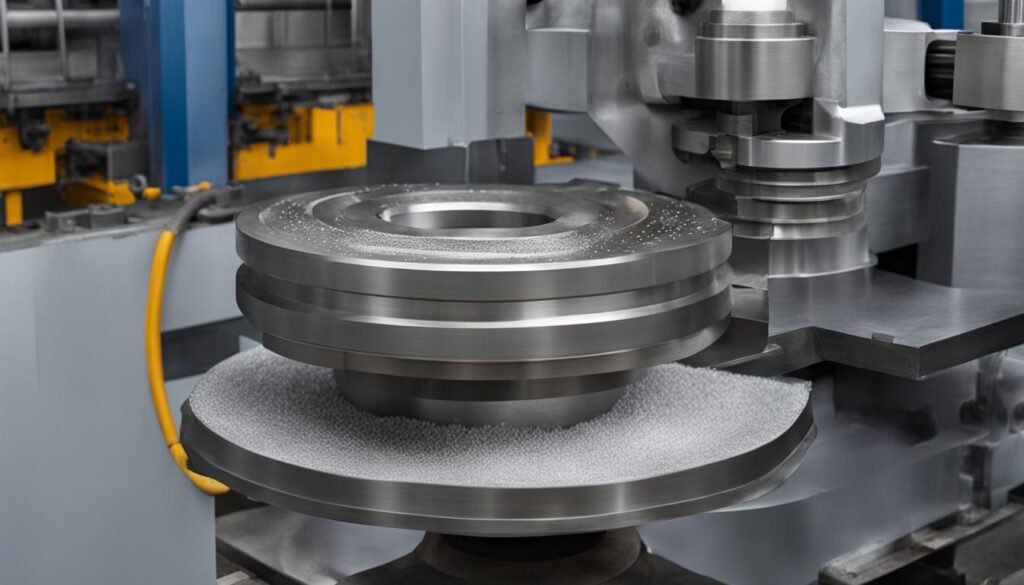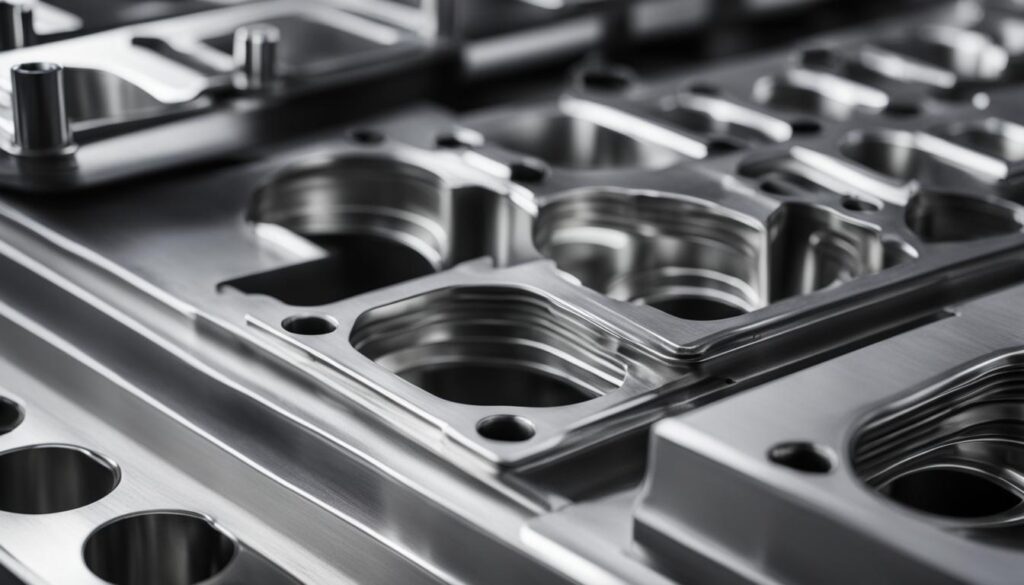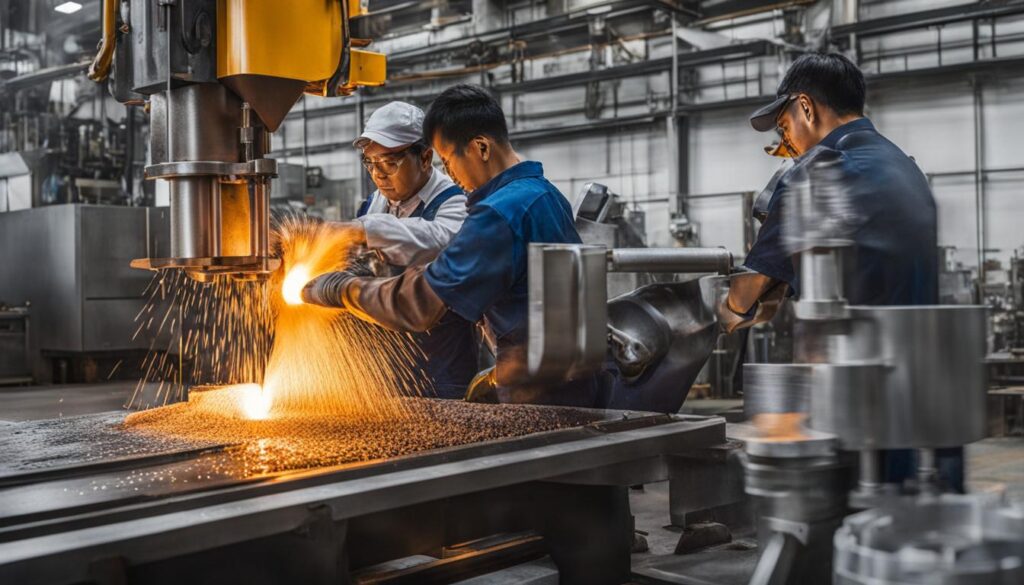Welcome to our article series on the fascinating world of low-pressure die casting. In this first section, we will explore the intricacies of the low-pressure aluminum die casting process and its significance in producing high-quality aluminum components.
Low-pressure die casting is a specialized technique that allows for the creation of complex shapes and precise details in aluminum components. Unlike other casting methods, low-pressure die casting utilizes a controlled environment to ensure consistent results. By injecting molten aluminum into a permanent mold at low pressure, this process enables the production of intricate designs with minimal porosity and excellent surface finish.
This method is particularly beneficial for components that require high strength and tight tolerances. The mold is sealed with a valve system to maintain the pressure during solidification, resulting in improved mechanical properties and reduced internal defects.

Key Takeaways:
- Low-pressure die casting is a specialized process that produces intricate aluminum components with precision and durability.
- This technique allows for the creation of complex shapes with minimal porosity and excellent surface finish.
- It is particularly suitable for components that require high strength and tight tolerances.
- The mold is sealed with a valve system to maintain pressure during solidification, resulting in improved mechanical properties and reduced internal defects.
- Low-pressure die casting offers numerous advantages compared to other casting methods, including better dimensional accuracy and surface finishes.
The Benefits of Low-Pressure Die Casting
Low-pressure die casting offers numerous advantages compared to other casting methods. Firstly, it allows for the production of complex shapes and thin-walled components with high precision and dimensional accuracy. The low-pressure environment minimizes the risk of porosity, ensuring higher integrity and strength of the final product. Additionally, low-pressure die casting results in better surface finishes, reducing the need for additional post-processing operations. The process also enables the use of a wide range of aluminum alloys, providing flexibility in material selection.
One of the key benefits of low-pressure die casting is the ability to create complex shapes and thin walls with a high level of precision and dimensional accuracy. This method allows for intricate details and tight tolerances, making it ideal for components that require intricate designs or have strict performance requirements. Moreover, the low-pressure environment during the casting process minimizes the risk of porosity, resulting in higher integrity and strength of the final product. This is especially important for components that need to withstand high mechanical stress or demanding operating conditions.
In addition to its precision and strength, low-pressure die casting also offers superior surface finishes. The controlled environment ensures that the molten aluminum fills the mold evenly, eliminating the need for extensive post-processing operations to achieve smooth and flawless surfaces. This not only reduces production time but also enhances the aesthetics of the finished components. Moreover, the process allows for the use of a wide range of aluminum alloys, providing manufacturers with the flexibility to choose the most suitable material for their specific application. Whether it’s a lightweight alloy for automotive parts or a high-strength alloy for aerospace components, low-pressure die casting can accommodate various material requirements.

Table: Comparison of Low-Pressure Die Casting with Other Casting Methods
| Factors | Low-Pressure Die Casting | Gravity Die Casting | High-Pressure Die Casting |
|---|---|---|---|
| Precision and Dimensional Accuracy | High | Medium | Medium |
| Surface Finish | Excellent | Good | Good |
| Porosity | Low | Medium | Medium |
| Material Flexibility | High | Medium | Medium |
Table: Comparison of Low-Pressure Die Casting with Other Casting Methods
The table above highlights the key factors that differentiate low-pressure die casting from other casting methods such as gravity die casting and high-pressure die casting. Low-pressure die casting excels in precision and dimensional accuracy, surface finish, porosity control, and material flexibility. These advantages make low-pressure die casting the preferred choice for applications that require intricate designs, superior aesthetics, and high mechanical performance.
The Low-Pressure Die Casting Process
The low-pressure die casting process is a carefully controlled method used to create intricate and precise aluminum components. This process involves several stages that ensure the production of high-quality and defect-free parts.
Firstly, the die used for casting is preheated to a specific temperature. This preheating step is crucial as it helps promote proper metal flow and solidification, resulting in components with uniform strength and integrity.
Next, the mold is sprayed with a lubricant or release agent. This coating prevents sticking and facilitates the filling of the mold, ensuring that the molten aluminum flows smoothly and accurately into the desired shape.
Once the mold is prepared, the molten aluminum is transferred to a holding furnace. Here, the temperature of the metal is carefully monitored to maintain optimal conditions for casting. The metal is also degassed to remove any impurities that could affect the quality of the final product.
Finally, the molten aluminum is injected into the mold cavity at low pressure. This controlled injection ensures even distribution of the metal and eliminates any voids or porosity in the finished component. The low-pressure environment also helps minimize the risk of defects, resulting in parts with excellent surface finish and dimensional accuracy.

Advantages of the Low-Pressure Die Casting Process
- High precision and dimensional accuracy
- Minimal porosity and defects
- Excellent surface finish
- Ability to produce complex shapes
- Wide range of aluminum alloys can be used
The low-pressure die casting process offers numerous advantages over other casting methods. It enables the production of components with high precision and dimensional accuracy, making it suitable for industries that require intricate and complex shapes. The process also ensures minimal porosity and defects, resulting in parts with excellent structural integrity and durability.
Additionally, low-pressure die casting provides superior surface finishes, reducing the need for additional post-processing operations. The process is highly versatile and can accommodate a wide range of aluminum alloys, allowing manufacturers to select the best material for their specific application.
Overall, the low-pressure die casting process is a reliable and efficient method for producing delicate and precise aluminum components. Its ability to create parts with high precision, minimal defects, and excellent surface finishes makes it an ideal choice for industries such as automotive, aerospace, and manufacturing.
| Advantages | Applications |
|---|---|
| High precision | Automotive industry: engine blocks, transmission cases |
| Minimal porosity and defects | Aerospace industry: turbine blades, structural components |
| Excellent surface finish | Consumer goods: electrical appliances, machinery parts |
Applications of Low-Pressure Die Casting
Low-pressure die casting is a versatile process that finds applications in various industries due to its ability to produce intricate and high-quality aluminum components. Let’s explore some of the common applications of low-pressure die casting:
Automotive Manufacturing
The automotive industry extensively utilizes low-pressure die casting for the production of critical components such as engine blocks, transmission cases, and suspension components. The process allows for the creation of lightweight yet durable parts with complex geometries, ensuring optimal performance and reliability on the road.
Aerospace Engineering
In the aerospace sector, low-pressure die casting is employed to manufacture intricate parts with high precision and strength. Components like turbine blades and structural elements in aircraft engines benefit from the process’s ability to produce complex shapes with minimal defects. The exceptional mechanical properties achieved through low-pressure die casting make it a preferred choice in an industry where safety and reliability are paramount.
Consumer Goods and Machinery Parts
Beyond automotive and aerospace, low-pressure die casting also has applications in producing consumer goods and machinery parts. From kitchen appliances to power tools, the process enables the creation of intricate and durable components that meet the demanding requirements of these industries. Manufacturers can achieve excellent surface finishes and dimensional accuracy, enhancing the overall quality and performance of the final products.
| Industry | Application |
|---|---|
| Automotive | Engine blocks, transmission cases, suspension components |
| Aerospace | Turbine blades, structural components |
| Consumer Goods | Kitchen appliances, power tools |
| Machinery | Parts for industrial machinery |
Overall, low-pressure die casting offers a reliable and efficient method for the production of delicate and precise aluminum components. Its applications span across industries, demonstrating its importance in delivering high-quality products that meet the stringent demands of modern manufacturing.
Conclusion
In conclusion, low-pressure die casting is a highly effective process for producing intricate and precise aluminum components. With its ability to create complex shapes, maintain dimensional accuracy, and minimize defects, this casting method is widely utilized in industries such as automotive, aerospace, and manufacturing.
By employing low-pressure die casting, companies can achieve exceptional strength, tight tolerances, and superior surface finishes. This not only reduces the need for additional post-processing operations but also ensures the production of high-quality, durable products that meet the demanding requirements of modern manufacturing.
At KT-Foundry, we pride ourselves on our expertise in low-pressure die casting. We are committed to delivering excellence and constantly pushing the boundaries of what is possible in this field. Our dedication to providing clients with exceptional aluminum components sets us apart as leaders in the industry.
FAQ
What is low-pressure die casting?
Low-pressure die casting is a specialized process used to create intricate aluminum components with precision and durability. It involves injecting molten aluminum into a permanent mold at low pressure, allowing for complex shapes to be formed with minimal porosity and excellent surface finish.
What are the benefits of low-pressure die casting?
Low-pressure die casting offers numerous advantages compared to other casting methods. It allows for the production of complex shapes and thin-walled components with high precision and dimensional accuracy. The low-pressure environment minimizes the risk of porosity, ensuring higher integrity and strength of the final product. The process also results in better surface finishes, reducing the need for additional post-processing operations. Additionally, it enables the use of a wide range of aluminum alloys, providing flexibility in material selection.
How does the low-pressure die casting process work?
The low-pressure die casting process involves several stages. First, the die is preheated to a specific temperature to promote proper metal flow and solidification. Next, the mold is sprayed with a lubricant or release agent to prevent sticking and facilitate mold filling. Molten aluminum is then transferred to a holding furnace, where it is degassed and its temperature is closely monitored. Finally, the molten metal is injected into the mold cavity at low pressure, ensuring even distribution and eliminating voids and porosity.
What are the applications of low-pressure die casting?
Low-pressure die casting is widely used in various industries. It is commonly employed in automotive manufacturing for the production of engine blocks, transmission cases, and suspension components. The aerospace industry also utilizes low-pressure die casting for intricate parts such as turbine blades and structural components. In addition, the process is used in the production of consumer goods, electrical appliances, and machinery parts.


